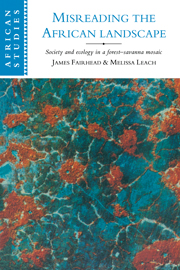Book contents
- Frontmatter
- Contents
- List of plates
- List of figures
- List of tables
- Note on authorship and research collaboration
- Acknowledgements
- Linguistic conventions
- Introduction
- 1 Convictions of forest loss in policy and ecological science
- 2 Forest gain: historical evidence of vegetation change
- 3 Settling a landscape: forest islands in regional social and political history
- 4 Ecology and society in a Kuranko village
- 5 Ecology and society in a Kissi village
- 6 Enriching a landscape: working with ecology and deflecting successions
- 7 Accounting for forest gain: local land use, regional political economy and demography
- 8 Reading forest history backwards: a century of environmental policy
- 9 Sustaining reversed histories: the continual production of views of forest loss
- 10 Towards a new forest–savanna ecology and history
- Appendix I Glossary of plant names
- Appendix II Cassette recordings of oral accounts and discussions
- Notes
- List of references
- Index
- Titles in the series
- Plate section
6 - Enriching a landscape: working with ecology and deflecting successions
Published online by Cambridge University Press: 05 June 2012
- Frontmatter
- Contents
- List of plates
- List of figures
- List of tables
- Note on authorship and research collaboration
- Acknowledgements
- Linguistic conventions
- Introduction
- 1 Convictions of forest loss in policy and ecological science
- 2 Forest gain: historical evidence of vegetation change
- 3 Settling a landscape: forest islands in regional social and political history
- 4 Ecology and society in a Kuranko village
- 5 Ecology and society in a Kissi village
- 6 Enriching a landscape: working with ecology and deflecting successions
- 7 Accounting for forest gain: local land use, regional political economy and demography
- 8 Reading forest history backwards: a century of environmental policy
- 9 Sustaining reversed histories: the continual production of views of forest loss
- 10 Towards a new forest–savanna ecology and history
- Appendix I Glossary of plant names
- Appendix II Cassette recordings of oral accounts and discussions
- Notes
- List of references
- Index
- Titles in the series
- Plate section
Summary
In the regional social history of Kissidougou's forest islands, and now in the lives of villagers in Sandaya and Toly, we have seen some of the many significances carried by trees, plants and vegetation forms for Kissidougou's rural inhabitants. In this chapter, we examine more closely how villagers consider and manipulate plant species and dynamics. We first look at how they value and understand the properties of particular trees and other plants. We then look at different ways that these species are propagated, first as individuals – in the enrichment of vegetation with particular species – and then as part of plant communities, in the enrichment of landscape with broader vegetation forms. Our emphasis is on the plants most commonly collected and used in everyday life, and on material and agricultural uses relevant to their broader landscape impact. We are interested in the extent to which villagers actively manipulate vegetation for different uses, or adapt their use of vegetation to the outcomes of change occurring for other reasons. In moving out from individual villages to the five study localities introduced in chapter 2, we are able to look comparatively at these issues across a range of forest–savanna mosaic conditions at the prefecture scale.
From the outset, French colonial botanists in Kissidougou were interested in the characteristics and uses of plants found locally, and were often impressed with indigenous knowledge concerning them.
- Type
- Chapter
- Information
- Misreading the African LandscapeSociety and Ecology in a Forest-Savanna Mosaic, pp. 176 - 209Publisher: Cambridge University PressPrint publication year: 1996



